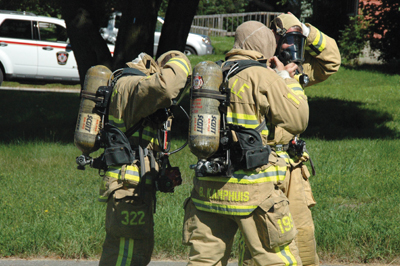
Features
Hot topics
Opinion
Letter to the editor: June 2011
Having recently returned from the Ontario Association of Fire Chiefs Annual Meetings and Educational Seminar (AMES), I sat down to read the May edition of Fire Fighting in Canada (FFIC). From the cover story on high-tech tools to the closing Flashpoint column, two themes rang out to me as I perused the magazine: change and safety.
May 18, 2011
By Fire Fighting in Canada
Dear editor,
Having recently returned from the Ontario Association of Fire Chiefs Annual Meetings and Educational Seminar (AMES), I sat down to read the May edition of Fire Fighting in Canada (FFIC). From the cover story on high-tech tools to the closing Flashpoint column, two themes rang out to me as I perused the magazine: change and safety.
 |
|
| Providing proper personal protective equipment is the responsibility of the employer. Wearing it is the responsibility of the employee.
|
The full spectrum – from equipment to administration to partnerships to code enforcement and organization – are covered and provide an interesting link between the two themes.
It was Peter Sells, in his Flashpoint column, (FFIC May 2011, page 78) who raised the issue of health-and-safety violations, and the fact that individuals are firstly responsible for their personal health and safety. He referenced a situation in which a firefighter received a burn injury while not wearing the personal protective equipment provided by his employer; the employer was cited for a violation of provincial health-and-safety legislation.
I feel it is important to acknowledge that I am not aware of the full details of the circumstances, but, to me, there sure seems to be a contradiction in those two statements. Based on the information, it appears to me that the employer provided protective equipment that the worker failed to properly utilize – as required by the worker under that same health-and-safety legislation – yet it is the employer’s fault that the worker was injured?
Later in the column, Sells asks if anyone has a solution for eliminating “unnecessary fire ground injuries” and, if so, he asks that they show us the plan. Well, since he asked, here’s a start: Let me take you back a few pages (FFIC, May 2011, page 58) to Jim Jessop’s piece on code enforcement. If complacency toward fire-code enforcement is leading to unnecessary fire-related injuries, deaths and property loss, then surely parallels can be drawn between failed enforcement of health-and-safety legislation and those who have the greatest control over their health and safety – the workers; this then results in unnecessary worker injuries. Therefore, this may be the place to start: enforce the legislation on workers who violate the legislation, just like it is enforced on the employer.
In cases like this, the inspector has failed by not enforcing the legislation and by not taking action against the worker. And if there is no penalty to the worker for failing to comply with the legislation, there is, then, little incentive to comply in the future, or for any other worker to comply, for that matter.
Some will argue that the injury was the penalty. Well, the circumstances surrounding this situation are all too common and, obviously, just knowing that injuries can result from failure to wear proper PPE isn’t working. If this same person had been driving his personal vehicle in a manner that contradicted the law – let’s say 20 kilometres an hour above the posted speed limit – and then lost control of the vehicle, resulting in significant damage to the vehicle and some minor injuries to the person, but no other property damage or persons involved, would the police then say, “Oh, it’s OK, we won’t charge you because you wrecked your car and got hurt?” I don’t think so. So, why is that kind of treatment acceptable for worker health-and-safety violations?
Perhaps a “change” may help to improve “safety”.
Sincerely,
Kevin Foster, Fire chief, Midland, Ont.
Fire Fighting in Canada welcomes letters to the editor. Letters may be edited for grammar, clarity and length. Please e-mail editor Laura King at lking@annexweb.com
Print this page